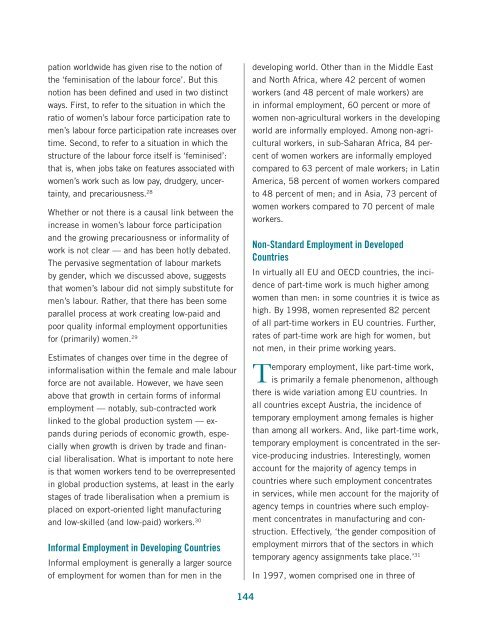Download the file - United Nations Rule of Law
Download the file - United Nations Rule of Law
Download the file - United Nations Rule of Law
You also want an ePaper? Increase the reach of your titles
YUMPU automatically turns print PDFs into web optimized ePapers that Google loves.
pation worldwide has given rise to <strong>the</strong> notion <strong>of</strong><strong>the</strong> ‘feminisation <strong>of</strong> <strong>the</strong> labour force’. But thisnotion has been defined and used in two distinctways. First, to refer to <strong>the</strong> situation in which <strong>the</strong>ratio <strong>of</strong> women’s labour force participation rate tomen’s labour force participation rate increases overtime. Second, to refer to a situation in which <strong>the</strong>structure <strong>of</strong> <strong>the</strong> labour force itself is ‘feminised’:that is, when jobs take on features associated withwomen’s work such as low pay, drudgery, uncertainty,and precariousness. 28Whe<strong>the</strong>r or not <strong>the</strong>re is a causal link between <strong>the</strong>increase in women’s labour force participationand <strong>the</strong> growing precariousness or informality <strong>of</strong>work is not clear — and has been hotly debated.The pervasive segmentation <strong>of</strong> labour marketsby gender, which we discussed above, suggeststhat women’s labour did not simply substitute formen’s labour. Ra<strong>the</strong>r, that <strong>the</strong>re has been someparallel process at work creating low-paid andpoor quality informal employment opportunitiesfor (primarily) women. 29Estimates <strong>of</strong> changes over time in <strong>the</strong> degree <strong>of</strong>informalisation within <strong>the</strong> female and male labourforce are not available. However, we have seenabove that growth in certain forms <strong>of</strong> informalemployment — notably, sub-contracted worklinked to <strong>the</strong> global production system — expandsduring periods <strong>of</strong> economic growth, especiallywhen growth is driven by trade and financialliberalisation. What is important to note hereis that women workers tend to be overrepresentedin global production systems, at least in <strong>the</strong> earlystages <strong>of</strong> trade liberalisation when a premium isplaced on export-oriented light manufacturingand low-skilled (and low-paid) workers. 30Informal Employment in Developing CountriesInformal employment is generally a larger source<strong>of</strong> employment for women than for men in <strong>the</strong>developing world. O<strong>the</strong>r than in <strong>the</strong> Middle Eastand North Africa, where 42 percent <strong>of</strong> womenworkers (and 48 percent <strong>of</strong> male workers) arein informal employment, 60 percent or more <strong>of</strong>women non-agricultural workers in <strong>the</strong> developingworld are informally employed. Among non-agriculturalworkers, in sub-Saharan Africa, 84 percent<strong>of</strong> women workers are informally employedcompared to 63 percent <strong>of</strong> male workers; in LatinAmerica, 58 percent <strong>of</strong> women workers comparedto 48 percent <strong>of</strong> men; and in Asia, 73 percent <strong>of</strong>women workers compared to 70 percent <strong>of</strong> maleworkers.Non-Standard Employment in DevelopedCountriesIn virtually all EU and OECD countries, <strong>the</strong> incidence<strong>of</strong> part-time work is much higher amongwomen than men: in some countries it is twice ashigh. By 1998, women represented 82 percent<strong>of</strong> all part-time workers in EU countries. Fur<strong>the</strong>r,rates <strong>of</strong> part-time work are high for women, butnot men, in <strong>the</strong>ir prime working years.Temporary employment, like part-time work,is primarily a female phenomenon, although<strong>the</strong>re is wide variation among EU countries. Inall countries except Austria, <strong>the</strong> incidence <strong>of</strong>temporary employment among females is higherthan among all workers. And, like part-time work,temporary employment is concentrated in <strong>the</strong> service-producingindustries. Interestingly, womenaccount for <strong>the</strong> majority <strong>of</strong> agency temps incountries where such employment concentratesin services, while men account for <strong>the</strong> majority <strong>of</strong>agency temps in countries where such employmentconcentrates in manufacturing and construction.Effectively, ‘<strong>the</strong> gender composition <strong>of</strong>employment mirrors that <strong>of</strong> <strong>the</strong> sectors in whichtemporary agency assignments take place.’ 31In 1997, women comprised one in three <strong>of</strong>144
















